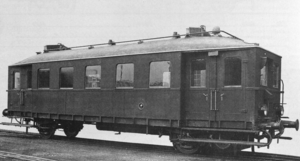DR 805 and 806
| DR 805-806 | |
|---|---|
|
DRG 805 I
|
|
| Numbering: | DRG : 805-806 |
| Number: | 2 |
| Manufacturer: | Machine factory in Esslingen |
| Year of construction (s): | 1927 |
| Retirement: | until 1932 |
| Type : | A1 dm |
| Genre : | BCvT |
| Gauge : | 1435 mm ( standard gauge ) |
| Length over buffers: | 12,800 mm |
| Length: | 11,500 mm |
| Height: | 3,893 mm to the top of the roof |
| Width: | 3,000 mm |
| Total wheelbase: | 7,000 mm |
| Service mass: | empty: 23,500 kg occupied: 28,750 kg |
| Top speed: | 60 km / h |
| Installed capacity: | 55 kW (75 PS) |
| Wheel diameter: | 1,000 mm |
| Motor type: | MAN W6V 11 (18) |
| Motor type: | Six-cylinder four-stroke diesel engine |
| Rated speed: | 1,100 rpm |
| Power transmission: | mechanical with four-speed gearbox from the Esslingen machine factory |
| Tank capacity: | 240 l |
| Brake: | Compressed air brake type Knorr |
| Seats: | 42 |
| Standing room: | 28 |
| Classes : | 2nd / 3rd |
The DR 805-806 were railcars developed by the Deutsche Reichsbahn Gesellschaft in the late 1920s for passenger traffic on branch lines . They are a modified version of the 801–804 with a modified car body. The vehicles had not been in operation for long and had not been used for passenger transport since the early 1930s.
history
These two vehicles were called Eßlinger railcars because of the manufacturer and the power transmission. They were withdrawn from passenger traffic as early as 1932 and their numbers were temporarily assigned to the later 135 000 and 001 , the first lightweight multiple units with diesel-electric power transmission .
The two railcars were ordered in 1925, and in July 1927 they were delivered to the Reichsbahndirektion Stuttgart . The vehicles were used in the Tübingen depot . In 1932 at the latest, they were converted into catenary test vehicles and used under inventory numbers 701 405 and 701 406 in the area of the Reich Railway Directorate in Halle .
Constructive features
The car body was a construction of a passenger car with a barrel roof in steel rivet construction, which was drawn in in the area of the entry areas to 2,440 mm and had entrance doors at the ends of the vehicle. The barrel roof of the car was pulled down at the ends. The passenger compartment was between the entry areas and was divided in the middle by a partition. It had a total of 42 seats. The drive was designed so that both axles were designed as free steering axles .
Contrary to series 801 to 804 , the machine system was arranged transversely to the direction of travel and consisted of the MAN W6V 11 (18) diesel engine and a four-speed gearbox from the Esslingen machine factory . Due to the transverse position, a cardan shaft with a bevel gear on the drive axle could be dispensed with, the bearing of the drive system was based on the principle of a pin-bearing drive . All power transmission spur gears were herringbone gears . All gear pairs of the transmission were constantly in mesh. The gears were shifted by oil pressure clutches. The switching of the reversing stage was also implemented by means of oil pressure clutches.
literature
- Heinz R. Kurz: The railcars of the Reichsbahn-Bauarten , EK-Verlag, Freiburg 1988, ISBN 3-88255-803-2
Web links
- Description of the railcars from the Reichsbahn era on reichsbahntriebwagen.de
Individual evidence
- ↑ a b c Heinz R. Kurz: The railcars of the Reichsbahn-Bauarten , EK-Verlag, Freiburg 1988, ISBN 3-88255-803-2 , page 90
- ^ Heinz R. Kurz: The railcars of the Reichsbahn-Bauarten , EK-Verlag, Freiburg 1988, ISBN 3-88255-803-2 . Page 91
- ↑ Heinz R. Kurz: The railcars of the Reichsbahn-Bauarten , EK-Verlag, Freiburg 1988, ISBN 3-88255-803-2 , page 92
